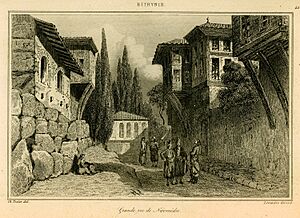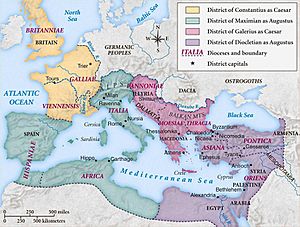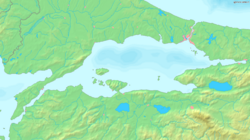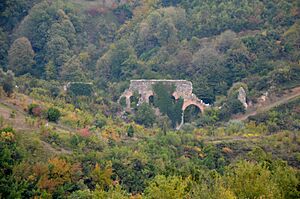Nicomedia facts for kids

French illustration of Nicomedia, 1882
|
|
| Location | Turkey |
|---|---|
| Region | İzmit, Kocaeli Province |
| Coordinates | 40°45′45″N 29°55′03″E / 40.76250°N 29.91750°E |
Nicomedia (pronounced nik-oh-MEE-dee-uh) was an ancient Greek city located in what is now Turkey. It was a very important city, especially during the time of the Roman Empire.
In the year 286 AD, Nicomedia became the eastern capital city of the Roman Empire. This happened when Emperor Diocletian chose it as his main city in the east. He set up a system called the Tetrarchy, where the empire was ruled by four emperors. Nicomedia remained a top capital city until 324 AD.
The Tetrarchy system ended after a big battle in 324 AD. Constantine defeated another emperor named Licinius. Constantine then became the only emperor of the Roman Empire. In 330 AD, Constantine decided to build a new capital city nearby. He chose a place called Byzantium, which he renamed Constantinople (today's Istanbul).
Later, Nicomedia became part of the Ottoman Empire. This happened after Sultan Orhan Gazi won a battle against the Byzantine Empire. The Byzantines briefly got the city back, but it finally fell to the Ottomans in 1419.
Contents
History of Nicomedia
Nicomedia was first founded around 712–711 BC. It was a colony built by people from a Greek city called Megara. Back then, it was known as Astacus, which means 'lobster'.
After being destroyed by a general named Lysimachus, the city was rebuilt. This happened in 264 BC by Nicomedes I of Bithynia, who was a king. He renamed the city Nicomedia after himself. Since then, it has been one of the most important cities in northwestern Asia Minor (modern-day Turkey).
A famous military leader named Hannibal Barca spent his last years in Nicomedia. He died nearby in a place called Libyssa. The well-known historian Arrian was also born in Nicomedia.
Nicomedia was the main city and capital of the Roman province of Bithynia. This was during the time of the Roman Empire. A Roman governor named Pliny the Younger wrote many letters about Nicomedia. In his letters, he mentioned several public buildings. These included a senate-house, an aqueduct (for water), a forum (a public square), and a temple. He also wrote about a large fire that caused a lot of damage to the city.
As mentioned, Emperor Diocletian made Nicomedia the eastern capital of the Roman Empire in 286 AD. This was when he started the Tetrarchy system.
Persecution of Christians in 303 AD
Nicomedia was at the center of a difficult time for Christians. This was known as the Diocletianic Persecution. It happened under Emperor Diocletian and his co-ruler Galerius.
On February 23, 303 AD, Diocletian ordered a newly built church in Nicomedia to be torn down. Its holy books were burned, and its valuable items were taken. The next day, he issued his "First Edict Against the Christians." This order meant similar actions would be taken against churches across the entire Roman Empire.
The destruction of the Nicomedia church caused a lot of fear in the city. Soon after, a fire destroyed part of Diocletian's palace. Sixteen days later, another fire broke out. Even though they investigated, no one was officially blamed for the fires. However, Galerius put the blame on the Christians. He ordered the execution of some palace officials, claiming they worked with Christians to start the fires. Soon, Diocletian and Galerius left Nicomedia.
Later Roman Empire

Nicomedia remained the eastern capital of the Roman Empire. This lasted until co-emperor Licinius was defeated by Constantine the Great in 324 AD. Constantine lived mainly in Nicomedia for the next six years. It served as his temporary capital city.
In 330 AD, Constantine declared the nearby city of Byzantium as the new capital. He renamed it Constantinople. Constantine himself died near Nicomedia in 337 AD. Even after Constantinople became the new capital, Nicomedia remained important. This was because it was located where major roads from Asia met, leading to the new capital.
However, a major earthquake hit Nicomedia on August 24, 358 AD. It caused huge damage, and a fire followed, making things even worse. Nicomedia was rebuilt, but it was smaller than before. In the 500s, Emperor Justinian I added new public buildings to the city. Because it was on the main roads to the capital, Nicomedia stayed an important military center. It played a big role in the Byzantine Empire's fights against the Caliphate (Islamic empires).
In 451 AD, Nicomedia's local church leader was given a higher rank. It became a "Metropolitan see," meaning it was a very important church center. In the 700s, Emperor Constantine V even set up his court there for a while. This happened when a plague forced him to leave Constantinople.
By the 840s, Nicomedia was the capital of a military district called the Optimatoi. By this time, much of the old city near the sea was abandoned. An Arab geographer described it as being in ruins, with people living mostly on the hilltop fortress. In the 1080s, the city was a main military base for Alexios I Komnenos. He used it in his battles against the Seljuk Turks. Both the First Crusade and Second Crusade also camped there.
The city was briefly controlled by the Latin Empire after the Fourth Crusade captured Constantinople in 1204. However, the Crusaders faced constant attacks from the nearby Empire of Nicaea. By 1207, the Crusaders agreed to leave Nicomedia in exchange for prisoners. The city stayed under Byzantine control for over a century after that. But after a Byzantine defeat in 1302, the rising Ottoman beylik (a Turkish state) threatened it. The Ottomans attacked and blocked the city twice before finally taking it in 1337.
Nicomedia remained under Ottoman control until the Battle of Ankara. This battle weakened the Ottomans, allowing neighboring states to demand their lands back. The Byzantines got Nicomedia and other areas back. However, this last period of Byzantine rule was short. Nicomedia was finally taken by the Ottomans for good around 1419.
City Life and Buildings
During the Roman Empire, Nicomedia was a busy and rich city. It had all the things a major Roman city would need. Nicomedia was known for having plenty of water. It had two or three aqueducts, which are structures that carry water. One of these was built even earlier, during the Hellenistic period.
Pliny the Younger, the Roman governor, wrote about how the people of Nicomedia wasted a lot of money. They spent it on an unfinished aqueduct that had problems twice. Emperor Trajan told Pliny to make sure the aqueduct was finished. He also asked him to investigate if anyone was corrupt and wasting money.
Under Emperor Trajan, there was also a large Roman army base in Nicomedia. Other public places included a theater, a street with columns (common in Greek cities), and a forum.
A major religious site was a temple dedicated to Demeter, a Greek goddess. It stood on a sacred hill above the harbor. The city also strongly adopted Roman religious practices. There were temples for Emperor Commodus and a special area for Augustus. A temple for the goddess Roma was also built.
In 253 AD, the city was attacked and looted by the Goths. But when Diocletian made it his capital in 283 AD, he rebuilt it in a grand way. He built a huge palace, a place to store weapons, a mint (where coins are made), and new shipyards.
Famous People from Nicomedia
Many important people were born or lived in Nicomedia:
- Diocletian (c. 244 – 311), a Roman emperor from 284 to 305.
- Arrian (c. 86/89 – c. after 146/160), a Greek historian, writer, and military commander.
- Saint George (died 303), a Christian martyr.
- Barbara of Nicomedia (3rd century), a Christian martyr.
- Pantaleon of Nicomedia (died 305), a Christian martyr.
- Adrian of Nicomedia (died 306), a Christian martyr.
- Anthimus of Nicomedia (died 303 or 311-12), a bishop and Christian martyr.
- Juliana of Nicomedia (died 304), a Christian martyr.
- Theopemptus of Nicomedia (died 303), a bishop and Christian martyr.
- Theophylact of Nicomedia (died 845), a bishop recognized as a Saint.
- Michael Psellos (1017 or 1078 – c. 1078 or 1096), a Greek writer, philosopher, and historian.
- Maximus Planudes (c. 1260 – c. 1305), a Greek scholar and translator.
- Aaron ben Elijah (1328/1329-1369), a Karaite Jewish philosopher.
Remains of the Ancient City
The old city of Nicomedia is mostly buried under the modern city of İzmit. This makes it hard to dig up and explore all of it. Before the city grew a lot in the 1900s, some ruins could be seen. These included parts of the Roman defensive walls and several aqueducts that brought water to Nicomedia.
Other remains include the foundations of a marble fountain from the 100s AD. There is also a large water storage tank in the city's Jewish cemetery. Parts of the old harbor wall can still be seen too.
In 1999, a big earthquake seriously damaged İzmit. But it also led to important discoveries of ancient Nicomedia. When people cleared away the debris, they found many ancient statues. These included statues of Hercules, Athena, Diocletian, and Constantine.
After the earthquake, local cultural groups started small excavations. They dug at a site believed to be Diocletian's Palace and a nearby Roman theater. In April 2016, a larger excavation of the palace began. Experts believe the site covers a very large area.
See also
- 20,000 Martyrs of Nicomedia
- Nicaea (present-day İznik, another important city in Bithynia. It was the temporary capital of the Byzantine Empire between 1204 and 1261. This was after the Fourth Crusade in 1204, until Constantinople was taken back. Nicaea was also the site of important church meetings, like the First Council of Nicaea and Second Council of Nicaea.)
- List of ancient Greek cities





